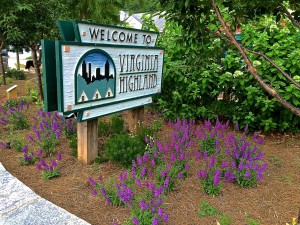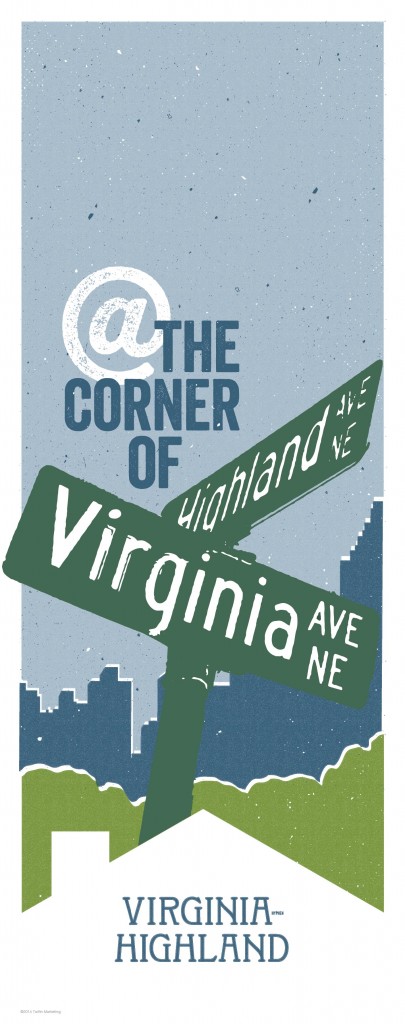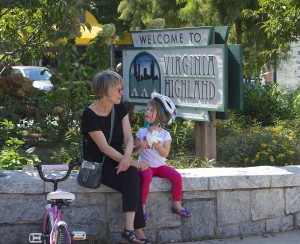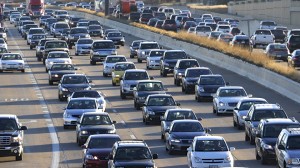Improvements On the Horizon for City of Atlanta
 By Jess Windham, Virginia-Highland Civic Association Board
By Jess Windham, Virginia-Highland Civic Association Board
Those passionate about transportation improvements in the city of Atlanta have experienced a roller coaster of emotions over the past few years. As a review of the list of projects included in the city’s upcoming proposed infrastructure bond reveals, we all now have something to look forward to.
The city of Atlanta is currently conducting a third and final round of public meetings for the upcoming Renew Atlanta 2015 Infrastructure Bond. Representing the city at a January 13 meeting were Public Works Program Management Officer Rodney Givens; Billy Warren, Director of Facilities Management in the Office of Enterprise Assets Management and ADA Coordinator; Chief Real Estate Officer for the Mayor Jalal Slade; Commissioner of Public Works Richard Mendoza; Katrina Taylor Parks, Deputy Chief of Staff for the Mayor’s Office; and Charletta Wilson Jacks, Director of the Office of Planning. All will play an important role in the implementation of projects included in the bond.
 The bond has two parts: transportation projects and municipal facilities. Each part will be voted on separately; $186,456,718 is being considered for transportation improvements and $63,543,282 for municipal facilities. A handful of projects would occur within Virginia-Highland. You’ll recall our neighborhood’s boundaries: the BeltLine to the west, Amsterdam to the north, Briarcliff to the east and Ponce de Leon to the south. Inside this area, six projects are on the proposed list:
The bond has two parts: transportation projects and municipal facilities. Each part will be voted on separately; $186,456,718 is being considered for transportation improvements and $63,543,282 for municipal facilities. A handful of projects would occur within Virginia-Highland. You’ll recall our neighborhood’s boundaries: the BeltLine to the west, Amsterdam to the north, Briarcliff to the east and Ponce de Leon to the south. Inside this area, six projects are on the proposed list:
- Inman Middle – School flashers for middle school at 774 Virginia Avenue
- Monroe Drive – Complete Street improvements inclusive of milling, resurfacing and pedestrian improvements from Piedmont Circle to Ponce de Leon Avenue
- Monroe Drive at Park: Replacement of traffic signal LED’s, cabinet, controller monitor, signal wiring, communications, & timing at the intersection.
- Monroe Drive at Amsterdam: Replacement of traffic signal LED’s, cabinet, controller monitor, signal wiring, communications, & timing at the intersection.
- Barnett Street – Resurfacing from Virginia Avenue to Ponce de Leon Avenue
- Barnett Street at Saint Charles Ave: Replacement of traffic signal LED’s, cabinet, controller monitor, signal wiring, communications, & timing at the intersection.
These projects represent only the tip of the iceberg of what would be improved with bond funding. Other inspiring projects include a number of streets to be converted to “Complete Streets” (more on that below), a citywide traffic signal upgrade, numerous road resurfacings, and school flashers for SPARK, Morningside Elementary and many other schools. A full list of proposed projects can be found on the city’s website. The site features a useful interactive map where you can make comments.
 “Complete Street” projects would significantly improve existing transportation corridors. The term refers to a set of policy and design principles adopted nationwide in communities looking to improve the variety and safety of their transportation options. In the words of Smart Growth America, Complete Streets “are designed and operated to enable safe access for all users, including pedestrians, bicyclists, motorists and transit riders of all ages and abilities.” (See link below.) This can include bike lanes, sidewalks, rapid transit lanes, or any number of comprehensive transportation infrastructure improvements. With this range of improvement recommendations, each specific Complete Street project must be customized for the unique street where the policy is applied. In our case, we’re talking Monroe Drive.
“Complete Street” projects would significantly improve existing transportation corridors. The term refers to a set of policy and design principles adopted nationwide in communities looking to improve the variety and safety of their transportation options. In the words of Smart Growth America, Complete Streets “are designed and operated to enable safe access for all users, including pedestrians, bicyclists, motorists and transit riders of all ages and abilities.” (See link below.) This can include bike lanes, sidewalks, rapid transit lanes, or any number of comprehensive transportation infrastructure improvements. With this range of improvement recommendations, each specific Complete Street project must be customized for the unique street where the policy is applied. In our case, we’re talking Monroe Drive.
Virginia-Highland’s Master Plan reiterated the need and consensus for improvements on Monroe Drive. With a fatal accident happening yet again last weekend, the call for improvements on Monroe has never been louder. The Master Plan recommendations, however, are much more specific than what is called for in the infrastructure bond. Those recommendations include support for the road diet recommended by Connect Atlanta and, additionally, a traffic circle at Park Drive. However, that may not at all be what the city ultimately implements. Before any improvements are made, a traffic study and further design will ultimately shape and determine the appropriate improvements to be made. At the end of the day, VHCA fully supports any improvement for safety on Monroe. It simply cannot happen soon enough.
 Within resurfacing projects, there is an opportunity for increasing Atlanta’s bike infrastructure as well. If a bike lane, cycle track, or sharrow path has been called for in a previously adopted plan, whether it be the Comprehensive Development Plan (CDP) itself or additions like the Connect Atlanta Plan or VaHi’s Master Plan, then bike infrastructure will be engineered into the project. This is a key element in making Atlanta a more healthy, sustainable and desirable place to live, especially as we compete globally with other cities for jobs and housing growth. Not to mention, having separate infrastructure for cyclists makes travel safer and smoother for everyone. VHCA will follow the resurfacing project proposed for Barnett Street and publicize any developments as they come available. The Master Plan made a handful of recommendations for improvements on Barnett Street and we would like to coordinate with the city and neighbors to see those improvements implemented.
Within resurfacing projects, there is an opportunity for increasing Atlanta’s bike infrastructure as well. If a bike lane, cycle track, or sharrow path has been called for in a previously adopted plan, whether it be the Comprehensive Development Plan (CDP) itself or additions like the Connect Atlanta Plan or VaHi’s Master Plan, then bike infrastructure will be engineered into the project. This is a key element in making Atlanta a more healthy, sustainable and desirable place to live, especially as we compete globally with other cities for jobs and housing growth. Not to mention, having separate infrastructure for cyclists makes travel safer and smoother for everyone. VHCA will follow the resurfacing project proposed for Barnett Street and publicize any developments as they come available. The Master Plan made a handful of recommendations for improvements on Barnett Street and we would like to coordinate with the city and neighbors to see those improvements implemented.
If the infrastructure bond is approved by voters in the upcoming election, the city expects to begin work on projects as soon as funding is available on or shortly after July 1, 2015. Similar to the Quality of Life bond projects undertaken more than a decade ago, working through the full list of projects included in this bond referendum is likely to take about five years.
What can you do to support improvements in Virginia-Highland and throughout the city? Vote for the bond on March 17th. If you aren’t registered to vote, you can do so on this website.
In the meantime, you can always submit regular maintenance and repair requests to the city’s new 311 system. Call 311 anytime or visit http://www.atl311.com/. For sidewalks, don’t forget that at this time citizens are ultimately responsible for sidewalk repairs to their adjacent property. This applies to both residential and commercial property owners. If the damage has been caused by a tree root in the city’s right of way, then the City is responsible and you should reach out to them for repairs. The topic of sidewalks in Atlanta is an entirely different can of worms and anyone interested in what the city is doing to improve sidewalks should closely follow the legislation proposed by city council representative Mary Norwood and eight of her peers. VHCA is also very interested in this topic and would be happy to discuss it with anyone interested.
For more information on Complete Streets, visit Smart Growth America’s website.
Click here to view the complete Virginia-Highland Master Plan.